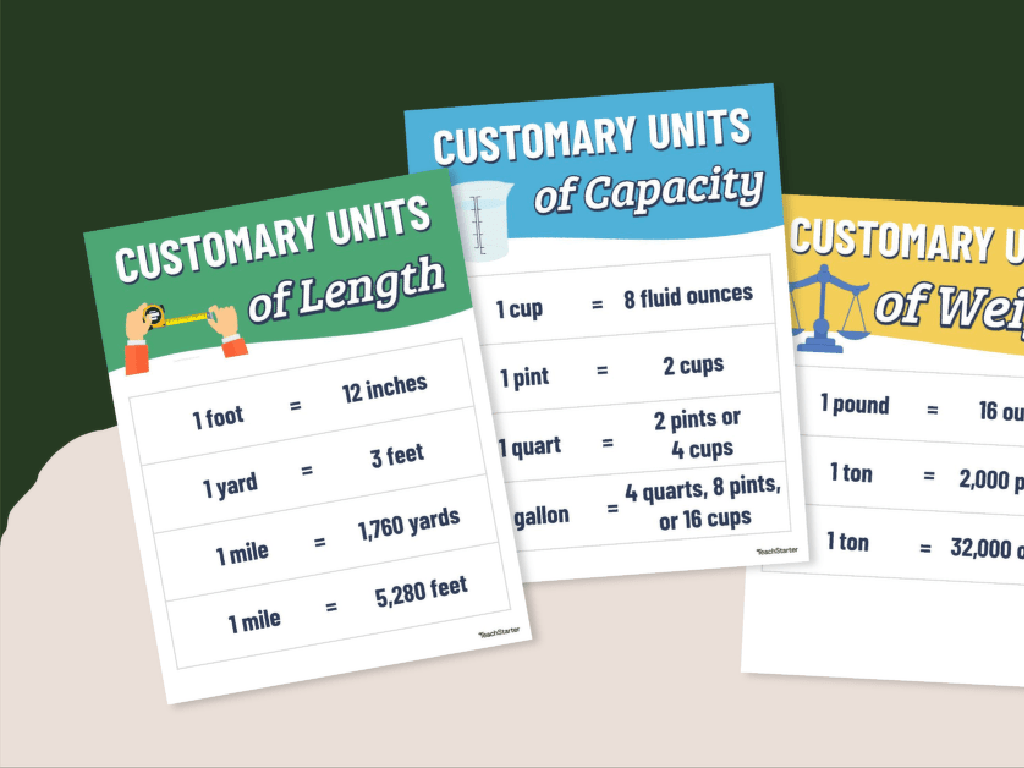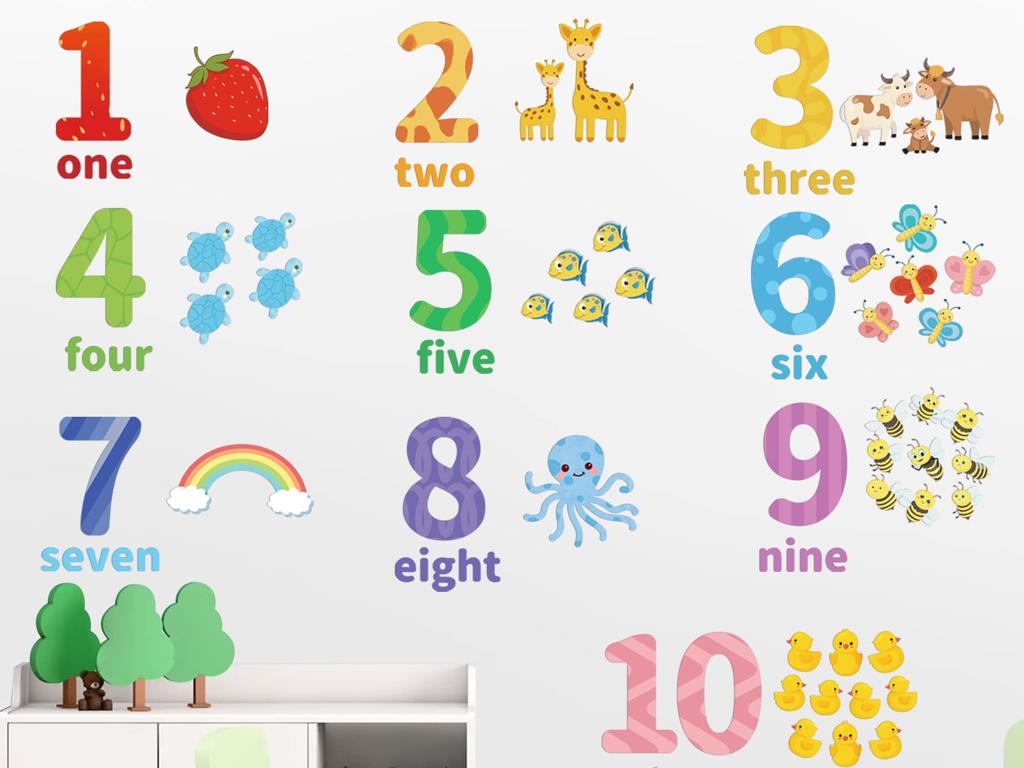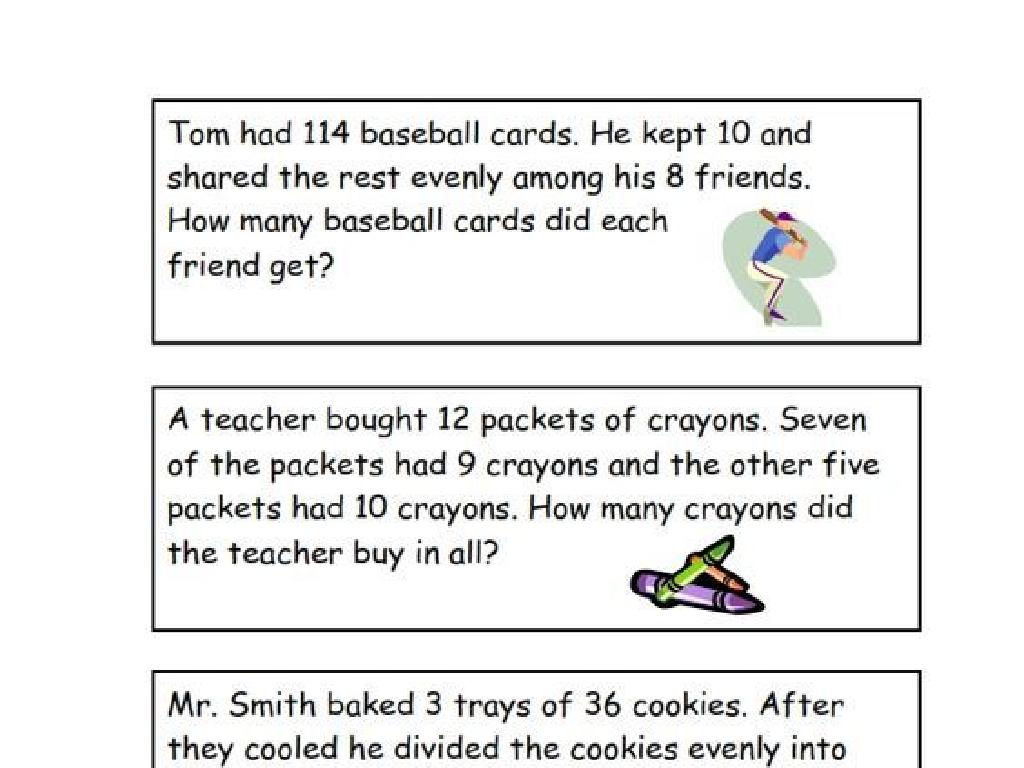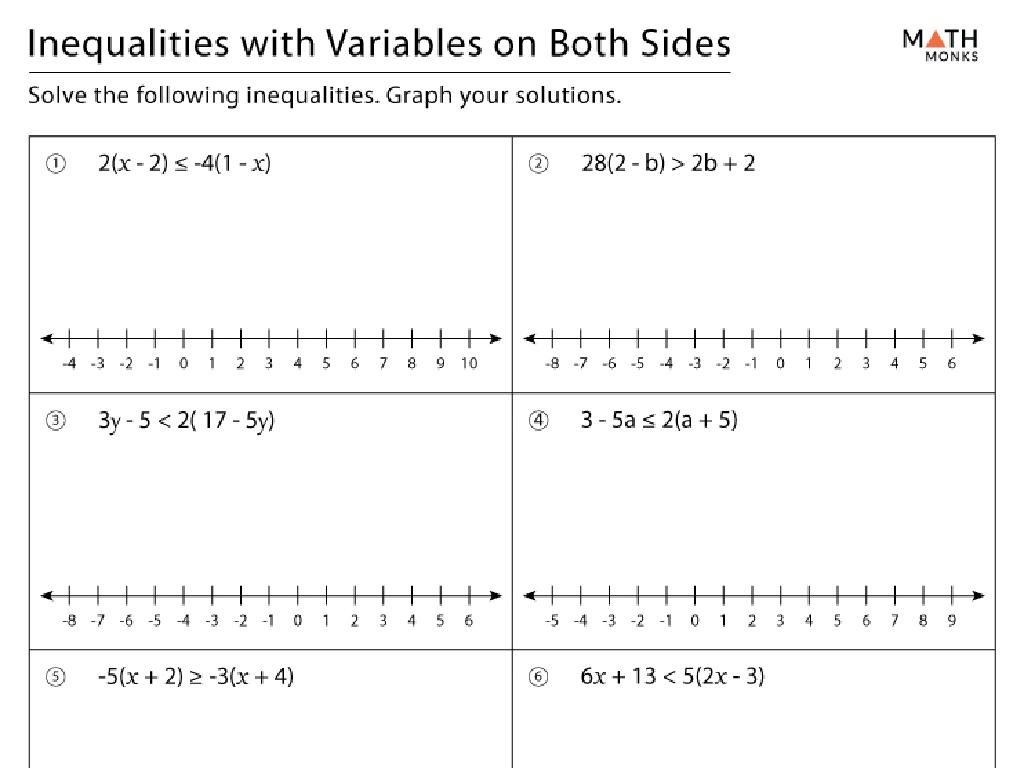Multiply Fractions To Find Area
Subject: Math
Grade: Fifth grade
Topic: Multiply Fractions
Please LOG IN to download the presentation. Access is available to registered users only.
View More Content
Multiplying Fractions to Find Area
– Understanding fractions basics
– Fractions represent parts of a whole, like a slice of pizza.
– Multiplication: combining groups
– Think of multiplication as adding a number to itself several times.
– Multiplying fractions for area
– To find the area of a shape, multiply the length by the width, which can be fractions.
– Practical applications in area
– Imagine finding the area of a garden plot or a book cover using fractions.
|
This slide introduces the concept of multiplying fractions to find the area of a shape. Begin by ensuring students have a solid understanding of what fractions represent, using tangible examples like slices of pizza. Clarify that multiplication is a way to combine equal groups, which can also apply to parts of a whole, or fractions. Emphasize that multiplying fractions is a useful skill for finding the area of shapes when the dimensions are not whole numbers, and provide real-world examples where this might be necessary, such as in measuring land or surfaces. Encourage students to visualize and draw examples to solidify their understanding.
Visualizing Fraction Multiplication with Area Models
– Area models represent fractions
– Draw a rectangle, divide it into equal parts to show fractions
– Multiply fractions using models
– Overlap two models to find the shared area representing the product
– Example: 1/2 multiplied by 1/3
– 1/2 area model overlaps with 1/3 model, shared section is 1/6
– Visualize the product as area
– The shared section of models shows the new fraction’s area
|
This slide introduces the concept of using area models to visualize the multiplication of fractions, which helps students understand the process beyond memorization. Start by explaining how to draw an area model for a fraction by dividing a shape into equal parts. Then, show how multiplying two fractions can be visualized by overlapping their respective area models to find the common area. Use the example of multiplying 1/2 by 1/3 to illustrate this, resulting in a shared area of 1/6, which represents the product of the multiplication. Encourage students to draw their own area models and practice with different fractions to solidify their understanding.
Multiplying Fractions to Find Area
– Step 1: Multiply the numerators
– Multiply the top numbers of the fractions
– Step 2: Multiply the denominators
– Multiply the bottom numbers of the fractions
– Simplify the resulting fraction
– Make the fraction as simple as possible
– Apply to find area
– Use multiplication to calculate the area of a shape
|
When teaching fifth graders to multiply fractions for finding area, start with the basics of fraction multiplication. Explain that the numerator is the top number and the denominator is the bottom number of a fraction. Demonstrate step by step how to multiply the numerators together to get a new numerator, and then the denominators to get a new denominator. Emphasize the importance of simplifying fractions to their lowest terms to make them easier to understand and work with. Finally, show how these skills can be applied to find the area of a rectangle or other shapes by multiplying the side lengths expressed as fractions. Provide examples and practice problems to reinforce the concept.
Multiplying Fractions: Practice Problems
– Problem 1: Multiply 2/5 by 4/7
2/5 * 4/7 = 8/35. Multiply numerators, then denominators.
– Problem 2: Multiply 3/8 by 1/4
3/8 * 1/4 = 3/32. Multiply across for both numerators and denominators.
– Step-by-step solution
– Understanding the area concept
Multiplying fractions helps find the area of a space.
|
This slide presents two practice problems to help students apply their knowledge of multiplying fractions to find areas. Start by guiding students through the multiplication of fractions step by step: multiply the numerators (top numbers) to get the new numerator, and multiply the denominators (bottom numbers) to get the new denominator. Emphasize that they do not need to find a common denominator when multiplying fractions. After solving the problems, relate the concept to finding the area of a space, such as a rectangle, where one side is a fraction of a unit and the other side is another fraction of a unit. Encourage students to visualize this by drawing rectangles with fractional side lengths. Provide additional practice problems if time allows, and ensure students understand the process before moving on.
Finding Area with Fraction Multiplication
– Understand rectangle area
– Area is length times width
– Apply fraction multiplication
– Multiply fractions for each side’s length
– Example: 1/2 ft by 1/3 ft rectangle
– Area = 1/2 ft * 1/3 ft = 1/6 ft²
– Practice with different fractions
|
This slide introduces the concept of finding the area of a rectangle using fraction multiplication, which is a key skill in understanding how to work with fractional dimensions. Start by reviewing the formula for the area of a rectangle (length times width) and then show how this formula applies when the sides are fractions. Use the example of a rectangle with sides of 1/2 foot and 1/3 foot to illustrate the process of multiplying these fractions to find the area. Encourage students to visualize the problem by drawing a rectangle and labeling the sides with the fractional lengths. After the example, provide additional problems with different fractional lengths for the students to practice. This will help solidify their understanding of the concept.
Real-World Application: Planning a Garden
– Multiplying fractions in daily life
– Example: Designing a garden layout
– Imagine planning where to plant flowers in your garden
– Calculate area for flower beds
– If a bed is 1/2 yard wide and 1/4 yard long, what’s the area?
– Use multiplication of fractions
– Multiply width (1/2) by length (1/4) to find the area
|
This slide aims to show students how multiplying fractions is used in real-life scenarios, such as planning a garden. Start by discussing how garden design requires precise measurements for planting. Then, present an example where students must calculate the area of a flower bed using fraction multiplication. For instance, if a flower bed is 1/2 yard wide and 1/4 yard long, students will multiply these fractions to find the area (1/2 x 1/4 = 1/8). This practical application helps students understand the importance of fractions in everyday tasks and enhances their comprehension of the concept by relating it to a tangible activity.
Class Activity: Design Your Fraction Garden
– Design a garden with fraction dimensions
– Calculate area of garden sections
– Multiply length by width to find area
– Use multiplication for mixed numbers
– Convert to improper fractions if needed
– Present your garden plan to the class
|
In this engaging class activity, students will apply their knowledge of multiplying fractions to design their own garden with fractional side lengths. They will calculate the area of each section of their garden by multiplying the fractional lengths and widths. Encourage students to be creative with their designs and to use a variety of fractional lengths. Provide guidance on how to multiply mixed numbers by converting them to improper fractions first. After calculations, students will share their garden plans with the class, explaining how they found the area of each section. This activity will help solidify their understanding of multiplying fractions in a fun and practical way. Possible activities include designing gardens with different themes, using different units of measurement, or incorporating different shapes into their garden plans.
Wrapping Up: Fractions and Area
– Recap: How to multiply fractions
– Multiply the numerators and denominators
– Why fractions matter for area
– Area calculation requires fraction multiplication for partial units
– Connecting area to real-world shapes
– Relate to finding areas of sections in fields or rooms
– Looking ahead: Dividing fractions
|
As we conclude today’s lesson, we’ll review the steps for multiplying fractions, emphasizing the importance of this skill in calculating the area of shapes that involve fractions. Understanding how to multiply fractions allows students to work with real-world problems, such as finding the area of a garden plot or a room that isn’t a whole number in size. This foundational skill will also be crucial as we move into our next lesson on dividing fractions. Encourage students to practice with additional problems and to start thinking about how division of fractions might work in preparation for the upcoming lesson.


-a-solution-to-the-linear-equation/linear_equation_graph_solutions.png)



